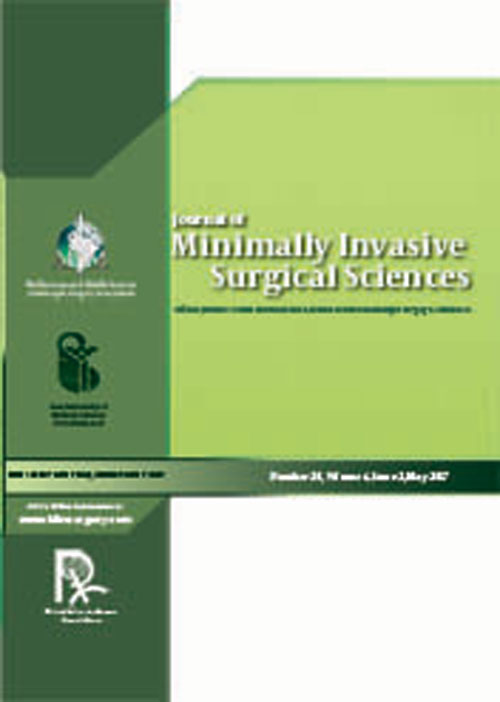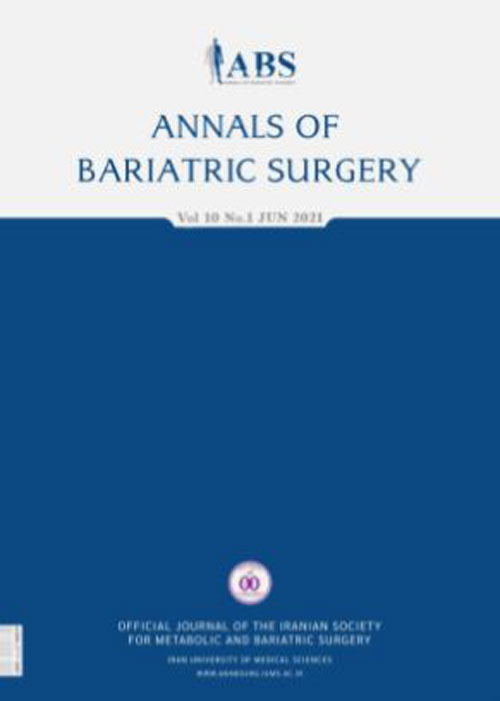فهرست مطالب

Annals of Bariatric Surgery
Volume:6 Issue: 2, Spring 2017
- تاریخ انتشار: 1396/02/30
- تعداد عناوین: 6
-
-
Page 2BackgroundParallel with the growing obesity problem in the world, the number of obese patients admitted to hospitals is soaring. With the hospitalization of the obese patients, healthcare team faces many challenges. Based on studies in many countries, most of the problems are related to inadequate equipment and space, shortage of nursing staff, high pressure on the staff for transferring patients, which causes physical damage. In this study, we examined problems related to the care of obese patients in Iran from the perspective of personnel in surgical wards and operating rooms.MethodsThis cross-sectional study was conducted in 2015. Data were collected using a three-section researcher-made questionnaire completed by the staff. The first part collected demographic information, while the second part pertained to patient's problems and the challenges that the staff faced regarding equipment and clinical activities. The third part covered personnels opinion about priorities of care of obese patients. The collected data were analyzed by statistical tests in SPSS software, Chi-square test, fisher exact test and descriptive statistic.ResultsTwo hundred people participated (25% male and 75% female) in this study. Regarding the equipment, the biggest challenges for the personnel were related to the lifters and then the clothing and bed sheets. Concerning clinical activities, repositioning the patient (56.1%), transferring between the wards and clinics and changing clothes were the biggest challenges. The participants believe the priorities for obese patient care include employing more staff and supplying equipment.ConclusionsTaking the increasing number of obese patients in hospitals along with the importance of staff health, and providing appropriate patient care, it is necessary to provide the required equipment for obese patient care and to educate the staff for delivering high-quality care.Keywords: Obesity, Nursing Care, Nurses, Patients, Equipment, Hospital
-
Page 3IntroductionAfter cessation of smoking, the best way to prevent health-threatening conditions is to treatment of obesity. Also, obesity treatment, cause alleviation or cure of other diseases. Bariatric surgery in selected obese patients is the best option for preventing health-threatening conditions. Despite the health benefits, this method of treatment -just like other surgical procedures- may be associated with various side effects.Case PresentationA 55-year-old female with BMI of 46.5 underwent laparoscopic Omega Gastric bypass surgery. She was admitted due to dyspnea and pulmonary embolism 14 days later. In conducted surveys, platelet count was less than 25,000. In multiple assessments, no cause found for the thrombocytopenia. Corticosteroids prescribed for her with the diagnosis of ITP; which fully responded to treatment.ConclusionsThrombocytopenia is a rare complication of gastric bypass surgery. Managements include rule out of other causes of thrombocytopenia and medical treatment.Keywords: Morbid Obesity, Thrombocytopenia, Bariatric Surgery
-
Page 4BackgroundNecrotizing soft tissue infections (NSTI (are a major surgical complication relating to skin wounds. Although laparoscopic surgeries often cause minimal wound infection, NSTI is still a potentially fatal surgical complication. This article is going to report a case of necrotizing soft tissue infection (NSTI) following laparoscopic total colectomy.Case PresentationAn otherwise healthy 65-year-old woman with early stage of colon adenocarcinoma underwent laparoscopic colectomy. A diagnosis of NSTI was made five days after primary operation. The culture grew Enterococcus Faecalis (sensitive to: ciprofloxacin, ampicillin, vancomycin, Gentamycin and linezolid). The patient was treated with broad-spectrum antibiotics and surgical debridement.ConclusionsWe report a case of NSTI with Enterococcus Faecalis following laparoscopic total colectomy. The isolated microorganism is not common in monobacterial NSTI. Administration of broad-spectrum antibiotics and surgical debridement help the patient to survive.Keywords: Necrotizing Soft Tissue Infection, Laparoscopy, Colorectal Adenocarcinoma, Case Report
-
Page 5BackgroundLaparoscopic repair of duodenal perforation using the omental patch is one of the traditional techniques, which gives better postoperative recovery in patients with little chances of abdominal wound infection. This article is about the technique used for the laparoscopic repair of the duodenal perforation by Grahams patch with a twist in the conventional technique.MethodsIn Hanging method of duodenal repair first, an intra-corporeal suture is taken at the upper margin of perforation and both end of the thread is taken out of anterior abdominal wall and duodenum is pulled up. Now under vision the next two parallel sutures are passed, thus avoiding the posterior duodenal wall incorporation. Finally omentum flap is used for the closure of perforation.ConclusionsThe laparoscopic closure of the duodenal perforation by Hanging Method is an appropriate Laparoscopic technique, as hanging the anterior wall of duodenum gives us better vision of the posterior wall of duodenum, while taking the suture through anterior duodenal wall. Further since the gall bladder is retracted there is an easy available working space for intracorporeal suturing.Keywords: Duodenal Ulcer, Hanging Method, Laparoscopic, Omental Patch, Suture


